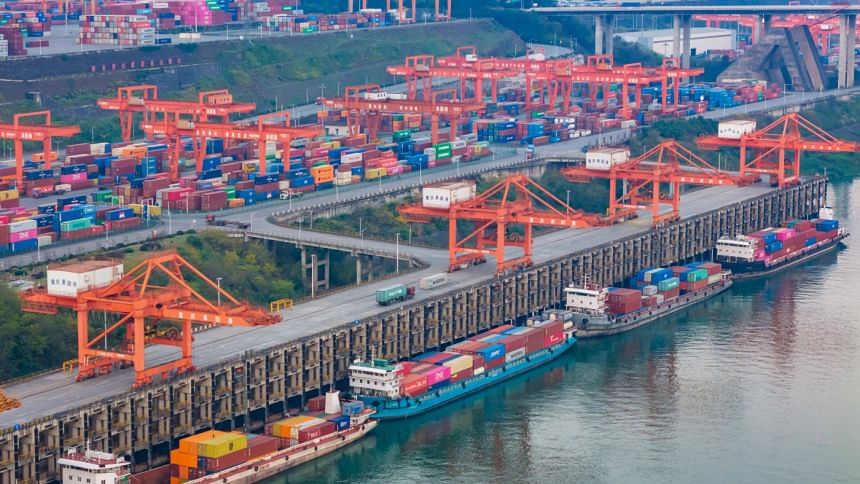Global trade dynamics amidst US–China tariff war

The impact of Trump's Reciprocal Tariff (TRT) remains uncertain, but it has undeniably divided the world into three distinct blocs: the US, China, and the rest of the world (ROW)—excluding Canada and Mexico, which appear to be caught in a no man's land. Among these, the US and China, the two largest global economic powers, are locked in a grueling tariff war, while the rest of the world has extended offers to negotiate.
The bilateral trade in goods between the US and China faces the risk of being severed due to the imposition of steep tariffs: a combined 125 percent plus 20 percent by the US against China, and a retaliatory 125 percent by China effective April 12, alongside the 15 percent tariff it enacted on March 10, 2025. These measures could severely hinder mutual sales, though the demand for these goods will persist. Both nations will need to seek alternative sources to fulfill their needs. Exports from these alternative sources in the ROW are subject to a 10 percent TRT, but China imposes no equivalent tariff on them.
Global impact of tariffs
The 10 percent TRT on countries outside the US and China is set to remain in effect for at least 90 days following the pause on April 10, 2025. If neither China nor the US backs down during this period, nations in the ROW could become increasingly attractive as intermediaries for trade between the two economic giants.
The trade volumes affected by these tariffs hold substantial global significance. In 2024, merchandise trade between the US and China totaled $583 billion, with $144 billion in US exports to China and $439 billion in imports from China to the US Due to the tariffs, China's share in US imports is forecasted to decrease from 14 percent to 4 percent (The Budget Lab, April 10, 2025), potentially creating approximately $167 billion in export opportunities for other nations to the US China's exports to the US are predominantly machinery, electronics, and telecommunications equipment—categories that include computers, broadcasting devices, and office machine parts. Other significant exports encompass clothing, textiles, and footwear.
In 2024, Chinese imports from the US accounted for 5.5 percent of their total imports. If this share decreases in proportion to the decline projected in the US, it could drop to 1.5 percent, thereby generating $105 billion in export opportunities for other countries to China. US exports to China encompass a wide range of products, including electronics, machinery, nuclear reactors, agricultural goods, oil, vehicles, plastics, pharmaceutical products, perfumes, toiletries, and cosmetics.
The above estimates are partially invalidated by the exemption from TRT granted to smartphones, semiconductors, chips, laptops, computer monitors and various electronic parts. But the general direction of change still holds, especially since the exemption does not include the 20 percent tariff on Chinese goods for China's alleged role in the fentanyl trade.
Under the TRT regime, the US and China will seek identical goods or close substitutes from third countries to replace trade that previously occurred directly between them (e.g., smartphones). Both countries will face elevated costs compared to pre-TRT levels. Trade with third countries will arise whenever the tariff-inclusive price from those nations is lower than the tariff-inclusive price of similar goods from China.
The wide gap between the US tariffs—10 percent TRT plus pre-exiting tariffs on most countries (total 25 percent in case of Bangladesh for instance) and 145 percent on Chinese goods except high tech items—makes other countries particularly appealing during the current TRT regime. While a reduction in the 10 percent TRT is possible after the 90-day period, the ongoing tit-for-tat tariffs between the US and China are likely to persist beyond this timeframe.
Redirection of US–China trade
Markets are quick to capitalise on ripe opportunities, often finding ways to navigate enduring trade barriers and exploit newly emerged arbitrage prospects. This can involve malpractices like transshipment—routing goods through third countries—or strategies such as resourcing and relocating operations to leverage tariff disparities. Consequently, fresh trade and investment opportunities will arise in sectors like textiles, footwear, machinery, and other categories within the broader US–China trade spectrum.
US garment and footwear importers can establish partnerships with companies in alternative locations, driving expansion in global production for these industries. US companies catering to Chinese consumers and producers often maintain production capacities outside the US—for instance, car manufacturing facilities in Mexico. Such companies can adopt similar redirection strategies, leading to increased production of goods that China imports from other parts of the world outside the US.
How will US and Chinese plants, previously dedicated to bilateral markets, handle the problem of excess capacity? They might contemplate relocating their operations, but such choices depend on understanding the future direction of tariffs and potential retaliations. Continued tariff escalation may be irrelevant to trade since the bilateral tariff levels have already reached prohibitive heights. Nevertheless, trade conflicts are unlikely to be limited to tariffs alone.
In the meantime, markets will prioritise utilising existing excess capacity. Businesses from the US and China may secure less favorable deals in third-country markets compared to their previous bilateral arrangements—but some trade is better than none. It's worth noting that entry into these non-US and non-China markets remains unaffected by new tariffs.
For instance, soft goods produced in China for the US market could be redirected to South and East Asia, while US-produced cars and agricultural goods initially intended for Chinese consumers might follow a similar path. Trade barriers impeding US exports to other regions could loosen through negotiations, fostering growth in exports from the US to other parts of the world.
These would reduce excess capacity in both nations. However, production growth cannot surpass existing excess capacity, as Chinese manufacturers are unlikely to invest in serving US markets, and vice versa. Nonetheless, increased exports from the ROW to both the US and China will contribute to global economic output.
A blessing in disguise?
The ongoing trade war between the US and China may inadvertently offer a modest boost to growth in the ROW, even as it dampens real GDP growth in both the US and China. Over the long term, not accounting for the latest exemptions, their economies were projected to shrink by 0.6 percent each, while the ROW could see a slight 0.07 percent increase in growth (The Budget Lab, ibid).
This potential boost becomes more likely the longer the tariff conflict persists. Bangladesh, in particular, stands to benefit significantly, as US consumers face price hikes of 64 percent for apparel and 44 percent for textiles (The Budget Lab, ibid), prompting a shift toward more affordable alternatives. Bangladesh, being a leading low-cost supplier, is well-positioned to capitalise on this shift.
However, there are important caveats. The outcomes of ROW negotiations with the US over the next 90 days will be closely monitored by the Chinese government and global businesses. The current high tariff levels are challenging to maintain, given the significant dispersion between the three blocs. The pause in tariff escalation reflects a retreat by White House influencers who oppose using the TRT as a negotiating tool rather than a means of revenue generation or manufacturing rehabilitation in the US. This retreat, however, is far from guaranteed, as political unpredictability remains a factor.
The trade war is ultimately too costly for both economic giants to sustain indefinitely. The essential question now is not whether they will yield, but who will concede first and how soon. Recent exemptions hint that resolution may come sooner than later. To President Trump, what some see as "blinking" is simply demonstrating "flexibility." Nevertheless, the drama continues, so stay tuned.

 For all latest news, follow The Daily Star's Google News channel.
For all latest news, follow The Daily Star's Google News channel. 



Comments